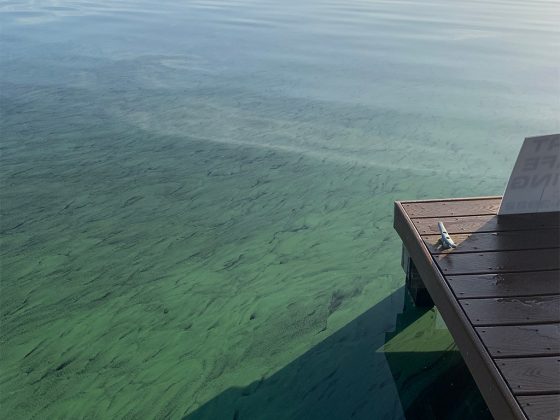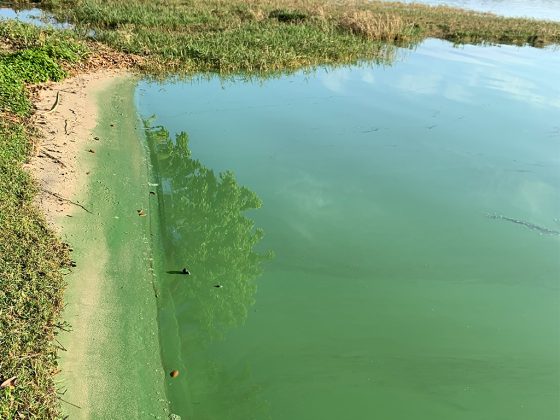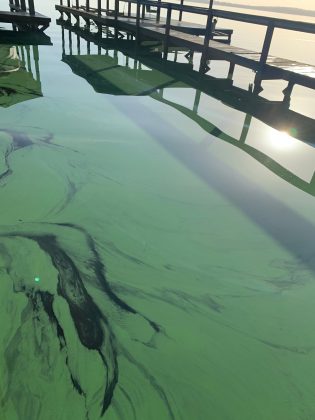Ron Hart, Lake County Water Authority Resources Director, recently came to a Clermont City Council meeting to discuss the condition of the lakes and how an algal bloom can affect fish, game, and humans.
The SOUTH LAKE TABLET had the opportunity to speak with Hart and learn more about Algal Blooms and our lakes.
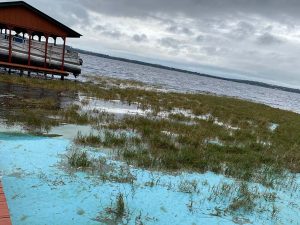 Tablet – Why has the Algae Bloom hit Lake Minneola so dramatically?
Tablet – Why has the Algae Bloom hit Lake Minneola so dramatically?
Hart – It is definitely related to an increase in Total Phosphorus, a form of nutrients, within the lake.
TABLET – I’ve heard lots of speculation regarding what is causing the severe Algae Bloom. Can you comment?
Hart – At this point, it is extremely premature to place blame on any single target. We need accurate information that details precise locations, including photos, to help in determining where we should collect data. Rumors regarding unsubstantiated discharges will only divert resources away from the areas where we should be looking.
TABLET: What about Victory Pointe, the stormwater project. Could that create a negative impact on the Lake?
Hart: The city has cooperated by collecting water quality data within the pond. We will evaluate and collect additional information to ensure it is functioning as intended. If we do find any issues at any potential locations, we plan on working with the jurisdictional agency in addressing the issue.
pictures taken on the west side of Lake Minneola on March 10
TABLET – There are lots of new lakefront/lake access projects being developed on the chain, one directly on Lake Hiawatha and the Palatlakaha River. Could the new subdivision directly on Lake Hiawatha and the Palatlakaha River be playing a part in the Algae Bloom?
Hart – The development was designed to intentionally not discharge to the Clermont Chain. Tomorrow a consultant working for us will inspect the area to ensure there are not any visible changes that would allow discharges to the chain. If anyone has any detailed information, please send a photograph along with the specific location and we will investigate.
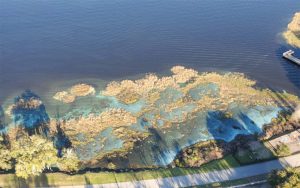
TABLET – Does an algal bloom present a health hazard to fish, wildlife, and humans?
Hart – Yes, cyanobacteria blooms can create toxins that are hazardous to humans, pets, and wildlife. However, we do not know what triggers the occasional production of toxins. To be safe, we always recommend avoiding contact with the water anywhere surface scums and dense blooms occur. The City has closed the beach during the worst of the bloom and we have advised them to do so whenever a bloom concentrates on the shore. We have collected samples around the lake and have analyzed the likely worst areas for potential toxins. The toxins measured at the worst public bathing area (west beach) was well below standards the State has established for public safety. In particular, the measured microcystin level was 2.1 ppb when the State recommends prohibiting contact at 8.0 ppb. This detection is still important because the levels could increase or decrease daily and be different at each location.
TABLET – Will this algae bloom remain long-term?
Hart – No, not at all. They are likely to dissipate and disappear for a while. However, these blooms appear to be occurring more frequently and are becoming more intense. These are issues that should rarely occur on this Outstanding Florida Waterbody and should cause concern.
TABLET – What can be done to make our lakes healthy and useable?
Hart – All sources of nutrients, particularly phosphorus, around the lake need to be reduced. As surrounding property owners, we are more likely to have a direct impact on water quality. Stormwater through pipes or from sheet flow during heavy rains has a direct impact to the lake. Fertilizers applied near the lake and surrounding hills can runoff along roadways and travel in the groundwater to the lake. We all play a part in the downfall of the lake and it may take all of us to keep it from getting worse.
TABLET – All things have a life span. Is our chain of lakes dying?
Hart – Due to the short lifespans of humans compared to lakes, we should not be able to discern the very long gradual natural changes over time. However, we can accelerate the rate that lakes decline in a process known as cultural eutrophication. This is when people impact the watershed and cause nutrient enrichment to occur far faster than what would ordinarily occur naturally.
TABLET – Is there anything else you’d like to tell the readers of the SOUTH LAKE TABLET?
Hart – The Lake County Water Authority Board of Trustees has funded investigatory sampling within and around the lake in an effort to determine potential causes that could increase the likelihood of blooms. There is rarely a smoking gun that would give a clear indication of a single cause. If there is, we will work with the responsible party and offer assistance in addressing the issue. It is more likely that it is the result of increasing nutrient loads from all sources combined.
****
TABLET – Lakefront property is a hot commodity. Everyone wants to live and play on the lakes. Developers are buying up large lakefront and lake access properties and selling lots to buyers who aren’t aware how to protect their most valuable investment, the lake.
If you are familiar with the Clermont chain of lakes, you’ll see drastic changes as you cruise along the shoreline. If the wind blows the right way, you can smell a musky odor and see a black oily-looking substance floating on the surface of the water. In some areas, the lake waters are pea green or turquoise. That’s an Algal Bloom (see Algal Bloom)
The width of the river that flows between Lake Hiawatha and Lake Minnehaha has dramatically widened. Boat docks are being built in locations that, in some cases, can reroute the flow of water, and there are man-made canals where wetlands had once been. Is this called progress?
To report an Algal Bloom, click Algal Bloom




